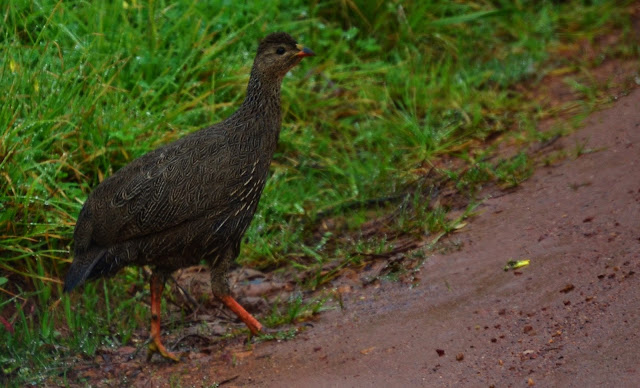Limietberg Nature Reserve
My personal experience of Limietberg Nature Reserve is that the easiest way to do some birding is to drive to the Tweede Tol camping site. From there you can take one of the few short hiking paths and walk into the mountains. Within a few minutes of walk you find yourself removed from any noises in the camping sites, and being surrounded by the most beautiful mountainous areas. Birding is limited to typical species found in the local fynbos, therefore do not expect too much with regards to birding.
My personal list of birds I have photographed at Limietberg Nature reserve is:
My personal list of birds I have photographed at Limietberg Nature reserve is:
Cape Turtle Dove, Greater Striped Swallow, Cape Bulbul, Familiar Chat, Cape Robin Chat, African Dusky Flycatcher, Cape Wagtail, Red-winged Starling, Malachite Sunbird, Orange Breasted Sunbird, Cape White-eye, Pin-tailed Whydah, Streaky-headed Seedeater and Cape Bunting.
 |
| Familiar Chat |
 |
| Cape Bunting |
 |
| Cape Bulbul |
According to Cape Nature Limietberg Nature Reserve is a pristine nature reserve tucked away in the Du Toitskloof Mountains, near Paarl. The reserve stretches from Franschhoek in the south, eastwards towards Groot Drakenstein, and northwards as far as Voëlvlei Dam.
Limietberg offers a number of beautiful hikes through steep kloofs and deep valleys. Du Toits Peak, at 1 996m, is the highest point within the reserve. Visitors can also visit the many historical sites along the trails, including ancient rock art, a disused manganese mine and the graves of convicts who helped build the Bainskloof Pass.
The reserve gets extremely hot and dry in summer, but in winter the high mountain peaks are capped with snow. When visiting Limietberg, please check the weather forecast, as hikers can get caught in unpredictable conditions and the mountainous terrain makes rescue operations difficult.
Tweede Tol is a perfect spot for picnicking, but to avoid disappointment we suggest you come early, as day visitors are limited to 120 people per day.
How to get there:
From Cape Town: Take the Klapmuts/ Wellington turn-off on N1. Turn left and drive for 20km until you get into Wellington. At the third set of traffic lights, turn left into Piet Retief Street and then right at the next set of traffic lights into Church Street. This will lead you into Bainskloof Pass towards Worcester. Tweede Tol will be on your left, about 16km from the Bainskloof Pass signboard, outside Wellington. Drive cautiously as the road through the pass is narrow.
GPS: 33 43 58.91S 19 07 16.14E
Office hours: 08:00–18:00
Tel: +27 (0)21 871 1535/6/7
Emergency tel: +27 (0)82 4949 707
Accommodation and permit bookings Tel: +27 (0)21 483 0190.
Emergency tel: +27 (0)82 4949 707
Accommodation and permit bookings Tel: +27 (0)21 483 0190.
According to Wellington Tourism The Nature Reserve stretches over a part of the Boland Mountain range and contains 9 different hiking trails through fynbos rich areas. The Tweede Tol campsite-cum-caravan park of 25 mostly shady sites is in Bainskloof Pass. The park is on the site of the old camp at which the prisoners who built the pass were kept, but things are more comfortable now. The ablution facilities, for instance, have hot showers.
Also part of the park is a day picnic site that can accommodate up to 120 people. Short, enjoyable hikes with stunning views are available to the camper, as are clear rock pools to cool off in on hot days. Peace and tranquility, especially during the week or outside of school holidays, is a certainty. There are a number of hiking trails and picnic places in the mountains and some of the most exquisite species of wildflowers can be seen at certain times of the year. Please obtain a permit from:
Wellington Tourism: +27 (0)21 873 4604/8
or
Cape Nature Conservation: +27 (0)21 483 2949
To Summarize:
The Limietberg Nature Reserve is good for birding, but the real allure lies in the astounding natural beauty of your surrounds and the wonderful hiking trials you can take. The facilities is a basic camping type setup with a river and swimming holes nearby. The facilities have more more potential than what is actually done with the place. I give Limietberg Nature reserve an overall B for the complete birding experience. 


